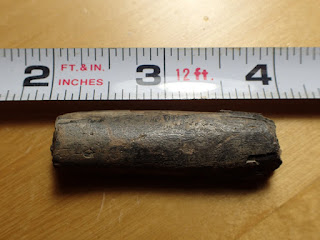When it's harder to get your kayak to and from the river
than it is to dig all day, that's when you know your
"Difficulty to yield" ratio is
SKEWED!
Unbeknownst to me, the last time we went to this location, Vickie and Pam did a "NEVER AGAIN" pinkie swear. I, on the other hand, having not been totally skunked, felt a little more exploration was called for. Once again, I found a few things but not enough to warrant all the effort.
I was happy to find a small sloth tooth:
I managed to find a small busted up meg but it looks so small in my hand:
I had Lilly hold it which made it look a bit bigger:
The best part was another set of very nice glyptodont scutes:
Here's a plate from the small fossil buffet:
Delicacies include shark vertebra, alligator teeth, antler butt, turtle scutes, etc.
It's a tasting menu.
Another good haul of small shark teeth:
The new waders held up well. They are a little heavier than my last ones and have the built in galoshes so I initially felt like I was in an astronaut suit but once I got used to it, I appreciated the extra protection around my foot. Much easier for shoveling. I've only used them once so we'll see...
Here's some more reading info on the ground sloth Glossotherium harlani, direct from Wikipedia:
Glossotherium (literally "Tongue Beast") was a genus of ground sloth.[1] It was a heavily built animal with a length of about 4 metres (13 ft) snout to tail-tip, a weight estimated at 1002.6 kg (2210.4 lb),[2] and could potentially assume a slight bipedal stance.
Sloths are grouped into three categories: mylodontids, megalonychids, and megatheriids. Glossotherium belongs to the Mylodontidae, in which it is further subcategorized into the Mylodontinae, characterized both by the loss of the entepicondylar foramen of the distal humerus and anteriorly broad snouts.[3]
Mylodontinae has five genera: Lestodon, Thinobadistes, Mylodon, Paramylodon, and Glossotherium. The latter three have frequently been confused for each other in scientific literature,[3] though it is likely Paramylodon and Glossotherium share a more recent common ancestor than with any other mylodontid.[4]Paramylodon is typically larger than Glossotherium, even though there is overlap in their size ranges, and Glossotherium is generally wider and more robust with a diagnostic increased amount of lateral flare at the predental spout.[4]
Glossotherium robustum was endemic to South America and weighed about 1500 kg.[5] Pleistocene records indicate that it was widely distributed between 20⁰S and 40⁰S, with a range spanning across Argentina, Brazil, Bolivia, Chile, Uruguay, and Paraguay.[6]
Dentition[edit]
Sloths have an ever-growing adult dentition. They lack deciduous dentition and have a reduction in tooth number. Sloth teeth also lack the enamel and cuspation pattern generally present in other mammals. Their tooth forms are oval, subrectangular, or elongate irregular ovoid with chisel-shaped “caniniform” teeth anteriorly and “molariform” cheek teeth. Glossotherium has a layer of cementum surrounding all molariform cheek teeth with some traces on caniniform teeth. Cheek teeth in Glossotherium are larger, have more complex shapes, and retain more of the cementum layer around all sides of each tooth than the Shasta ground sloth, Nothrotheriops shastensis, and tree sloths.[3]
Details of Glossotherium’s diet are unclear since no dung deposits are available for analysis. However, based on dental evidence, Glossotherium was likely more suited to grazing, though it was also probably less efficient at ingesting grasses since its dental apparatus was more suited to shearing, which would have been too ineffective at processing plant materials down to an ingestible size to obtain adequate nutritive value. More recent tree sloths have a very slow rate of passage of food through the gut and it is likely that Glossotherium did as well. With a likely low metabolic rate, a large body size, a consequently reduced energy requirement for its weight, and an extraordinarily large gut that likely had a foregut fermentation site, Glossotherium could probably survive better on foods of lower nutritional value than other sloths could. Though it is likely Glossotherium primarily ate grasses, it also probably ate a variety of foliage as well and would be better considered a “browser-grazer” than simply a grazer.[3]
Hearing[edit]
Glossotherium had large ear ossicles, similar to those in elephants, which imply the loss of hearing acuity of higher frequencies, further implying an advantage for sensing low frequency sounds, infrasound, or bone-conducting seismic waves.[5] Low frequency sound is useful for long range communication and it is possible that ground sloths used low frequency communication in much the same way that it is utilized by elephants. Sloths may have used low frequency sounds for communication in mating calls or other social interactions, or for long-range sound sensing as in predator-prey interactions or weather forecasting.[5] Another possible explanation for hearing in low frequencies may be due to fossorial habits: low hearing frequencies coupled with a short interaural distance suggest that Glossotheriumprobably had very poor sound localization. This indicates evidence of an underground lifestyle since loss of high frequency hearing is common to fossorial mammals.[9] Glossotherium’s huge nostrils were likely effective for sound emission, with expanded nares possibly related to emission of low frequency sounds up to 600 Hz.[5]

































